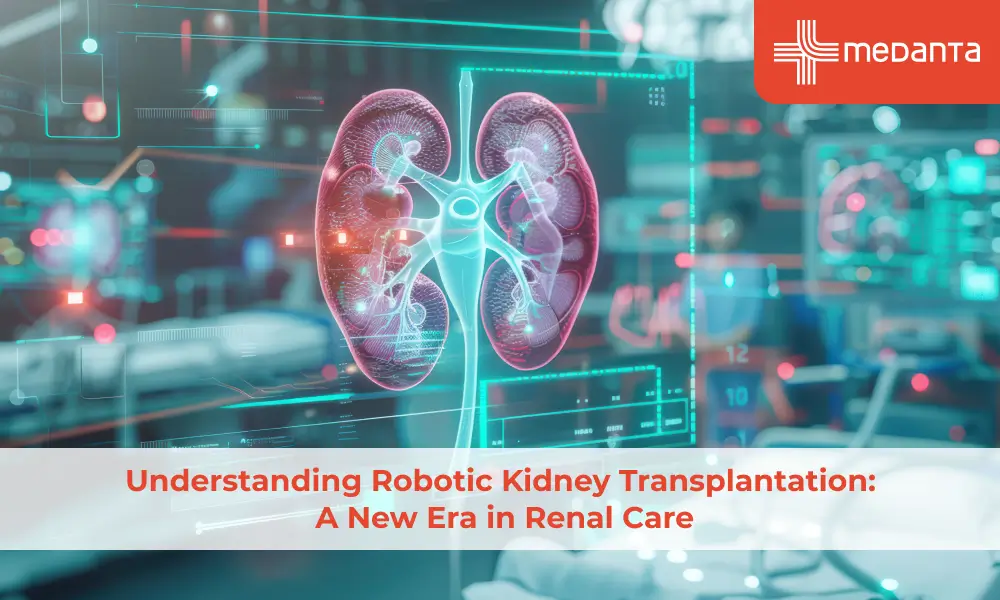Understanding Robotic Kidney Transplantation: A New Era in Renal Care

In the past 45 years, India's living kidney transplantation programme has developed and is now, in terms of participants, the second-largest programme after the United States. Since 1995, when the Indian Parliament established the law pertaining to transplantation, it has been permissible to get a transplant from a deceased donor when neurological criteria are used to determine death. Globally, chronic kidney disease is thought to contribute to about 735,000 annual deaths. Between 151 and 232 cases of end-stage renal illness necessitating transplantation are thought to occur in India for every million people.
In India, it is predicted that over 220,000 people need kidney transplants if these numbers are averaged out. However, against the same, only 7500 kidney transplants are performed. Currently, only 10% of transplanted kidneys originate from deceased donors and 90% come from the living donors.
With the changing times, there has been a progressive upgrade towards more transplant hospitals offering laparoscopic donor nephrectomy along with the revolutionary offering- Robotic Kidney Transplantation.
What is this groundbreaking invention's greatest gift, then? The issues with surgical and medical complications after kidney transplantation have now been resolved. The advantages of this minimally invasive surgery has been extended to the field of renal transplantation via robotic kidney transplantation (RKT). In order to justify its widespread use and guarantee safe and efficient innovation, techniques around the world have varied, and there is a need for standardization within evidence-based frameworks.
When it comes to Medanta, we explore every avenue! Our Kidney and Urology Institute was founded by skilled groups of urologists and nephrologists under the direction of two medical titans- Dr Rajesh Ahlawat, Dr Vijay Kher & their team. Since its inception, the Institute has been outfitted with cutting-edge technology to provide precise, individualized patient treatment, including the Da Vinci robot. Over 2500 robotic procedures and 2000 kidney transplants have been completed by the expert team at Medanta. Since the year 2000, laparoscopic surgery has been used for all donor nephrectomies. The Da Vinci robot was used in conjunction with surgical competence in kidney transplant to extend the advantages of minimally invasive surgery to kidney transplant patients.
In 2012, scientists from the Medanta Kidney and Urology Institute in Gurugram and the Vattikuti Urology Institute at Henry Ford Hospital in Detroit, USA, together developed the concept of robotic kidney transplantation. Phase 0 (preclinical investigations on cadavers), phase 1 and phase 2 trials were successfully carried out within the context of IDEAL standards, demonstrating the viability and safety of the process. To maximize the benefit to the patient, the procedure was continuously improved. The invention of the hypothermia technique, which uses ice slush to keep the kidneys cool while they were being robotically implanted, was a significant innovation. Regional hypothermia with ice slush produced improvements in renal function comparable to open kidney transplants. To fix the grafts in place and make them accessible for percutaneous biopsies during the post-transplant period, another method was developed. Numerous worldwide peer-reviewed journals published the findings.
Our expert, Dr Ahlawat has launched the robotic kidney transplant programme and given demonstrations of it on numerous international and Indian platforms throughout the years. Numerous individuals who have undergone kidney transplants have benefited from the technique's wide acceptance and good results. This has also led to a decrease in complications from procedures. In robotic surgery, robotic technology uses tiny, precise motions of little devices within a patient's body to mimic the surgeon's hand movements. The sophisticated camera offers increased magnification and 3D vision, which improves visibility of the surgical area and increases accuracy and precision for the surgeon, who maintains complete control over the system.
We are proud to reveal that our team of experts at Medanat have successfully completed approximately 300 robotic kidney transplants. At a year's follow-up, graft survival is 93.6% while patient survival is 95%. The reported death-censored graft survival rate is 98.6%. With less risk of problems, blood loss, and pain, the treatment has been safely carried out. Graft performance has been comparable to that of an open kidney transplant, and early recovery and discharge have resulted.
Dr. Prasun Ghosh.
____________________________________________________________________________
Reference links:
https://indianexpress.com/article/explained/why-kidney-transplantation-rackets-thrive-7954512/
https://www.ndtv.com/offbeat/robotic-kidney-transplants-are-here-548533
https://www.medanta.org/patient-education-blog/the-exchange-newsletter-february-2019/
https://www.ncbi.nlm.nih.gov/pmc/articles/PMC4970385/






